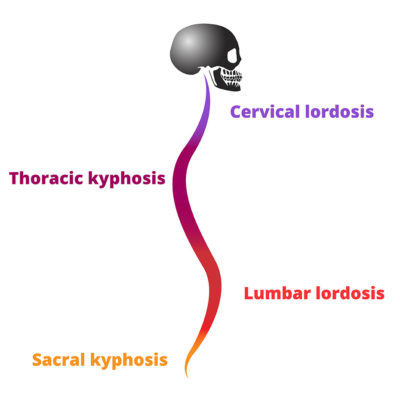Neck Pain and Posture
The idea of perfect posture has been around for a very long time. Our parents and schoolteachers would tell us to sit up straight as this was the key to having a healthy spine. Many experts in the field of rehabilitation persist in this recommendation. The term is often referred to as spine neutral, whereby the patient sits or stands in a manner that keeps the spine in a perfect anatomical position. In other words, when you look at the spine from the side, we see the normal cervical lordosis, thoracic kyphosis and lumbar lordosis.
In recent years, many experts have challenged the importance of perfect posture. In fact, this line of thinking hasn’t been limited to desk sitting and standing but also exercise. I’ve posted many blogs on our site about this concept, but the idea that you must adopt a very precise and specific movement pattern when performing gym exercises isn’t based on scientific evidence. I often suggest a compromise. Be aware of what we’ve all recommended for decades but be cognizant of what the current science suggests. The compromise is to try and sit with “proper posture,” but don’t beat yourself up about slouching now and again. If you feel worse when you sit with proper posture, utilize positions that feel good as well. When in the gym, do your best to move in the generally accepted ways, but if you feel more confident and comfortable straying a little from these ideal movement patterns, go ahead and do what is more comfortable.
In short, the current science would generally suggest that we don’t need to worry so much about perfect posture and copy the anatomically perfect pictures we see in the anatomy texts. We can go ahead and move our bodies in different ways, and they likely won’t feel a negative impact from doing this.
 When viewed from the side, a typical cervical x-ray (neck x-ray) has a curvature called lordosis. Lordosis means there is a distinct curve in the neck when viewed from the side. When a patient attends our clinic after a whiplash injury, we usually see the curve is temporarily straightened due to muscular spasm.
When viewed from the side, a typical cervical x-ray (neck x-ray) has a curvature called lordosis. Lordosis means there is a distinct curve in the neck when viewed from the side. When a patient attends our clinic after a whiplash injury, we usually see the curve is temporarily straightened due to muscular spasm.
As the whiplash recovers and the muscle’s spasm resolves, the normal cervical curve is re-established. Recently Dr. McDowall and I participated in some radiology continuing education. The professor leading the seminar is someone who looks at a lot of neck x-rays.
Interestingly, he commented during the seminar that nowadays, most neck x-rays are quite straight when viewing the spine from the side. We all agreed that the curvature is lost due to muscle spasms because so many people are staring at cell phones and computer screens. I’ve heard the term “text neck” being used as a way to describe this common scenario of neck pain and muscle stiffness after prolonged poor posture when staring at devices.
The traditional recommendation in rehabilitation and society was to sit with perfect posture.
In recent years, research on the topic hasn’t found that it correlates with pain and disability. Although I have yet to find any research that has quantified the prevalence of straightened necks in the general population, this anecdotal finding raises a few questions.
- Are more people losing the natural cervical lordosis?
- If more people in the population are losing these curves, is it safe to assume it’s from staring at devices?
- Does it matter?
Does a loss of cervical lordosis correlate with future pain or disability?
If this is a sign that we will see more pain and neck pain-related disability in the future, when will this be predicted to occur?
These are valid questions to ask, and further research on the topic is warranted. For the time being, it probably makes sense to compromise. Logically, try to limit how long you strain your neck staring at your cellphone or laptop. Try and move around often. You don’t need an x-ray for this, nor would I be alarmed if your neck has lost its lordosis on a side view x-ray. At the same time, I would use this finding as a reminder to strengthen your neck and try to be more mindful of your static postures. Just because the research hasn’t proven that slouching is bad for you, it also hasn’t found that slouching is particularly good for you either! Perhaps there will be research published in the future that recognizes this change in the population and the implications (or not) that it has.
By: Dr. Kevin McIntyre B.Kin., DC








